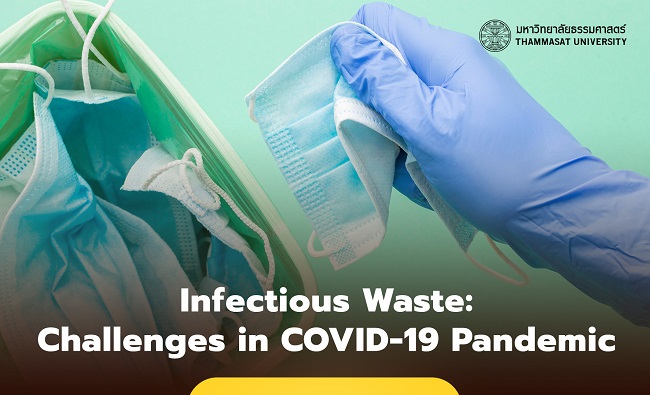Infectious Waste: Challenges in COVID-19 Pandemic
Thammasat University, Lampang Campus, organized a panel discussion on “Can we talk? EP.5: Infectious Waste: Challenges in COVID-19 Pandemic”
Wednesday 8 September 2021

Thammasat University, Lampang Campus, organized a panel discussion on “Can we talk? EP.5: Infectious Waste: Challenges in COVID-19 Pandemic” focusing on issues of infectious waste management during the COVID-19 pandemic through online media. Dr. Nattakorn Chuchuay, Assistant to the President for Management and Academic Affairs, Lampang Campus, Dr. Pradabduang Kiattisaksiri, Lecturer at Faculty of Public Health, Thammasat University, Lampang Campus and Mr. Supawit Amornyut, Public Health Expert, Health center for Ethnic Group, Marginal People and Migrant Worker participated as lecturers.
Dr. Pradabduang Kiattisaksiri from the Faculty of Public Health, Thammasat University, Lampang Campus said that due to the current COVID-19 pandemic, the amount of infectious waste has increased from sources that operate according to government policies and public assistance, such as field hospitals. Hospitels, Vaccine Pop-Ups, Home Isolation and Community Isolation. The most common wastes are face masks, Antigen Test Kit (ATK), Personal Protective Equipment (PPE) and face shields. In addition, in case of home isolation, if the patient has ordered food delivery, the wastes include used food containers and tissue paper. It is likely to be contaminated and become infectious waste. They need to be handled properly to prevent the spread of virus.
Mr. Supawit Amornyut, Public Health Expert, Health center for Ethnic Group, Marginal People and Migrant Worker said that as for the example of infectious waste management at Lampang Hospital, the autoclaving is used in accordance with the procedures prescribed by law. Biological standards must be checked by spore test. As for the disposal by incineration, the temperature of the incineration chamber must be controlled as prescribed by law and as for the infectious waste management in field hospitals and waiting areas, it is technically not different from the management in hospitals which focuses on hygiene and safety, collection method, infectious waste transportation procedures, operators, materials and disposal method that must comply with the law. For those who isolate at home, they are suggested to manage infectious waste that can be done at home as instructed as follows: dispose infectious waste inside the infectious garbage bag (red bag), close tightly the bag with disinfectant spray then put it into another garbage bag, gather them in the safe spot and coordinate with relevant responsible units, such as local administrative organizations, private companies, community hospitals or sub-district health promotion hospitals for further disposal. If there is no collection service in the area, pack the infectious waste in a black garbage bag with disinfectant and put it into another bag along with the written label specifying the type of waste inside the bag.
Dr. Nattakorn Chuchuay, Assistant to the President for Management and Academic Affairs, Lampang Campus concluded that the current infectious waste situation is not uncommon. All of us can create infectious waste, which is at least a face mask that is used regularly. It is considered an infectious waste because it might be contaminated by secretions. In terms of policy management, it was found that here are many problems as mentioned by various media or academic reports. Therefore, it is an important issue for infectious waste management and should be improved urgently, for example, policy advocates should seriously find the root cause of the problem, accelerate the improvement of the policy to be in line with the real practices and create mechanisms to handle problems. In addition, agencies involved in spatial management, personnel, officials and people must be aware of the infectious waste overflow crisis and work together to change behaviors to reduce the amount of infectious waste. Moreover, they should support each other for waste disposal operations to avoid the critical condition.